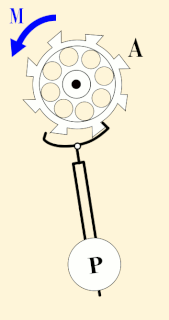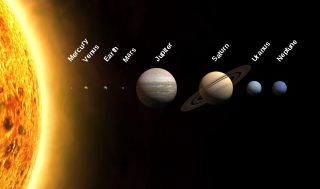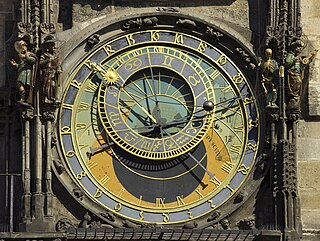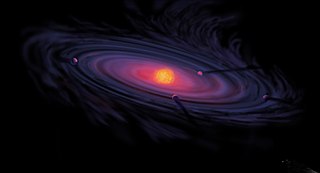- A tellurion made in 1766, used by John Winthrop to teach astronomy at Harvard
- Tellurion made between 1700 and 1725, on display at the Musée des Arts et Métiers, Paris
Related Research Articles
The term ephemeris time can in principle refer to time in association with any ephemeris. In practice it has been used more specifically to refer to:
- a former standard astronomical time scale adopted in 1952 by the IAU, and superseded during the 1970s. This time scale was proposed in 1948, to overcome the disadvantages of irregularly fluctuating mean solar time. The intent was to define a uniform time based on Newtonian theory. Ephemeris time was a first application of the concept of a dynamical time scale, in which the time and time scale are defined implicitly, inferred from the observed position of an astronomical object via the dynamical theory of its motion.
- a modern relativistic coordinate time scale, implemented by the JPL ephemeris time argument Teph, in a series of numerically integrated Development Ephemerides. Among them is the DE405 ephemeris in widespread current use. The time scale represented by Teph is closely related to, but distinct from, the TCB time scale currently adopted as a standard by the IAU.

The second is the base unit of time in the International System of Units (SI), commonly understood and historically defined as 1⁄86400 of a day – this factor derived from the division of the day first into 24 hours, then to 60 minutes and finally to 60 seconds each. Analog clocks and watches often have sixty tick marks on their faces, representing seconds, and a "second hand" to mark the passage of time in seconds. Digital clocks and watches often have a two-digit seconds counter. The second is also part of several other units of measurement like meters per second for speed, meters per second per second for acceleration, and cycles per second for frequency.

The Solar System is the gravitationally bound system of the Sun and the objects that orbit it, either directly or indirectly. Of the objects that orbit the Sun directly, the largest are the eight planets, with the remainder being smaller objects, the dwarf planets and small Solar System bodies. Of the objects that orbit the Sun indirectly—the natural satellites—two are larger than the smallest planet, Mercury, and one more almost equals it in size.
A time standard is a specification for measuring time: either the rate at which time passes or points in time or both. In modern times, several time specifications have been officially recognized as standards, where formerly they were matters of custom and practice. An example of a kind of time standard can be a time scale, specifying a method for measuring divisions of time. A standard for civil time can specify both time intervals and time-of-day.

Astronomy is a natural science that studies celestial objects and phenomena. It uses mathematics, physics, and chemistry in order to explain their origin and evolution. Objects of interest include planets, moons, stars, nebulae, galaxies, and comets. Relevant phenomena include supernova explosions, gamma ray bursts, quasars, blazars, pulsars, and cosmic microwave background radiation. More generally, astronomy studies everything that originates beyond Earth's atmosphere. Cosmology is a branch of astronomy that studies the universe as a whole.

The giant-impact hypothesis, sometimes called the Big Splash, or the Theia Impact, suggests that the Moon formed from the ejecta of a collision between the proto-Earth and a Mars-sized planet, approximately 4.5 billion years ago, in the Hadean eon. The colliding body is sometimes called Theia, from the name of the mythical Greek Titan who was the mother of Selene, the goddess of the Moon. Analysis of lunar rocks, published in a 2016 report, suggests that the impact may have been a direct hit, causing a thorough mixing of both parent bodies.

A natural satellite is in the most common usage, an astronomical body that orbits a planet, dwarf planet, or small solar system body. While natural satellites are often colloquially referred to as moons, there is only the Moon of Earth.

An orrery is a mechanical model of the Solar System that illustrates or predicts the relative positions and motions of the planets and moons, usually according to the heliocentric model. It may also represent the relative sizes of these bodies; however, since accurate scaling is often not practical due to the actual large ratio differences, a subdued approximation may be used instead. Though the Greeks had working planetaria, the first orrery that was a planetarium of the modern era was produced in 1704, and one was presented to Charles Boyle, 4th Earl of Orrery – hence the name. They are typically driven by a clockwork mechanism with a globe representing the Sun at the centre, and with a planet at the end of each of the arms.

Celestia is a 3D astronomy software program created by Chris Laurel. The program allows users to virtually travel through a simulated version of our universe. Celestia can display objects of various scales using OpenGL.

Orbiter is an open source space flight simulator program developed to simulate spaceflight using realistic Newtonian physics. The simulator was released on 27 November 2000; the latest edition, labeled "Orbiter 2016", was released on 30 August 2016, the first new version of the simulator since 2010.

An astronomical clock, horologium, or orloj is a clock with special mechanisms and dials to display astronomical information, such as the relative positions of the Sun, Moon, zodiacal constellations, and sometimes major planets.

The Sweden Solar System is the world's largest permanent scale model of the Solar System. The Sun is represented by the Avicii Arena in Stockholm, the largest hemispherical building in the world. The inner planets can also be found in Stockholm but the outer planets are situated northward in other cities along the Baltic Sea. The system was started by Nils Brenning, professor at the Royal Institute of Technology in Stockholm, and Gösta Gahm, professor at the Stockholm University. The model represents the Solar System on the scale of 1:20 million.

The formation and evolution of the Solar System began about 4.5 billion years ago with the gravitational collapse of a small part of a giant molecular cloud. Most of the collapsing mass collected in the center, forming the Sun, while the rest flattened into a protoplanetary disk out of which the planets, moons, asteroids, and other small Solar System bodies formed.

Rasmus Jonassen Sørnes, was a Norwegian inventor, clockmaker and radio technician, and is most famous for his advanced astronomical clocks, the most precise of which has an inaccuracy of 7 seconds during 1000 years. During his lifetime, Sørnes also designed and built a large variety of agricultural, radio-technical and mechanical devices, only a few of them patented.

An astrarium, also called a planetarium, is the mechanical representation of the cyclic nature of astronomical objects in one timepiece. It is an astronomical clock.

WorldWide Telescope (WWT) is an open-source set of applications, data and cloud services, originally created by Microsoft Research but now an open source project hosted on GitHub. The .NET Foundation holds the copyright and the project is managed by the American Astronomical Society and has been supported by grants from the Moore Foundation and National Science Foundation. WWT displays astronomical, earth and planetary data allowing visual navigation through the 3-dimensional (3D) Universe. Users are able to navigate the sky by panning and zooming, or explore the 3D universe from the surface of Earth to past the Cosmic microwave background (CMB), viewing both visual imagery and scientific data about that area and the objects in it. Data is curated from hundreds of different data sources, but its open data nature allows users to explore any third party data that conforms to a WWT supported format. With the rich source of multi-spectral all-sky images it is possible to view the sky in many wavelengths of light. The software utilizes Microsoft's Visual Experience Engine technologies to function. WWT can also be used to visualize arbitrary or abstract data sets and time series data.

The history of scientific thought about the formation and evolution of the Solar System began with the Copernican Revolution. The first recorded use of the term "Solar System" dates from 1704. Since the seventeenth century, philosophers and scientists have been forming hypotheses concerning the origins of our Solar System and the Moon and attempting to predict how the Solar System would change in the future. René Descartes was the first to hypothesize on the beginning of the Solar System; however, more scientists joined the discussion in the eighteenth century, forming the groundwork for later hypotheses on the topic. Later, particularly in the twentieth century, a variety of hypotheses began to build up, including the now-commonly accepted nebular hypothesis.

The origin of the Moon is usually explained by a Mars-sized body striking the Earth, making a debris ring that eventually collected into a single natural satellite, the Moon, but there are a number of variations on this giant-impact hypothesis, as well as alternative explanations, and research continues into how the Moon came to be. Other proposed scenarios include captured body, fission, formed together, planetesimal collisions, and collision theories.
The following outline is provided as an overview of and topical guide to the Solar System:

Theia is a hypothesized ancient planet in the early Solar System that, according to the giant-impact hypothesis, collided with the early Earth around 4.5 billion years ago, with some of the resulting ejected debris gathering to form the Moon.
References
- ↑ De Carle, D. (1988). Watch and Clock Encyclopedia. London: NAG/Robert Hale.
- ↑ Shipley, Joseph Twadell (2001). The Origins of English Words: A Discursive Dictionary of Indo-European Roots. JHU Press. p. 403. ISBN 0801867843.


